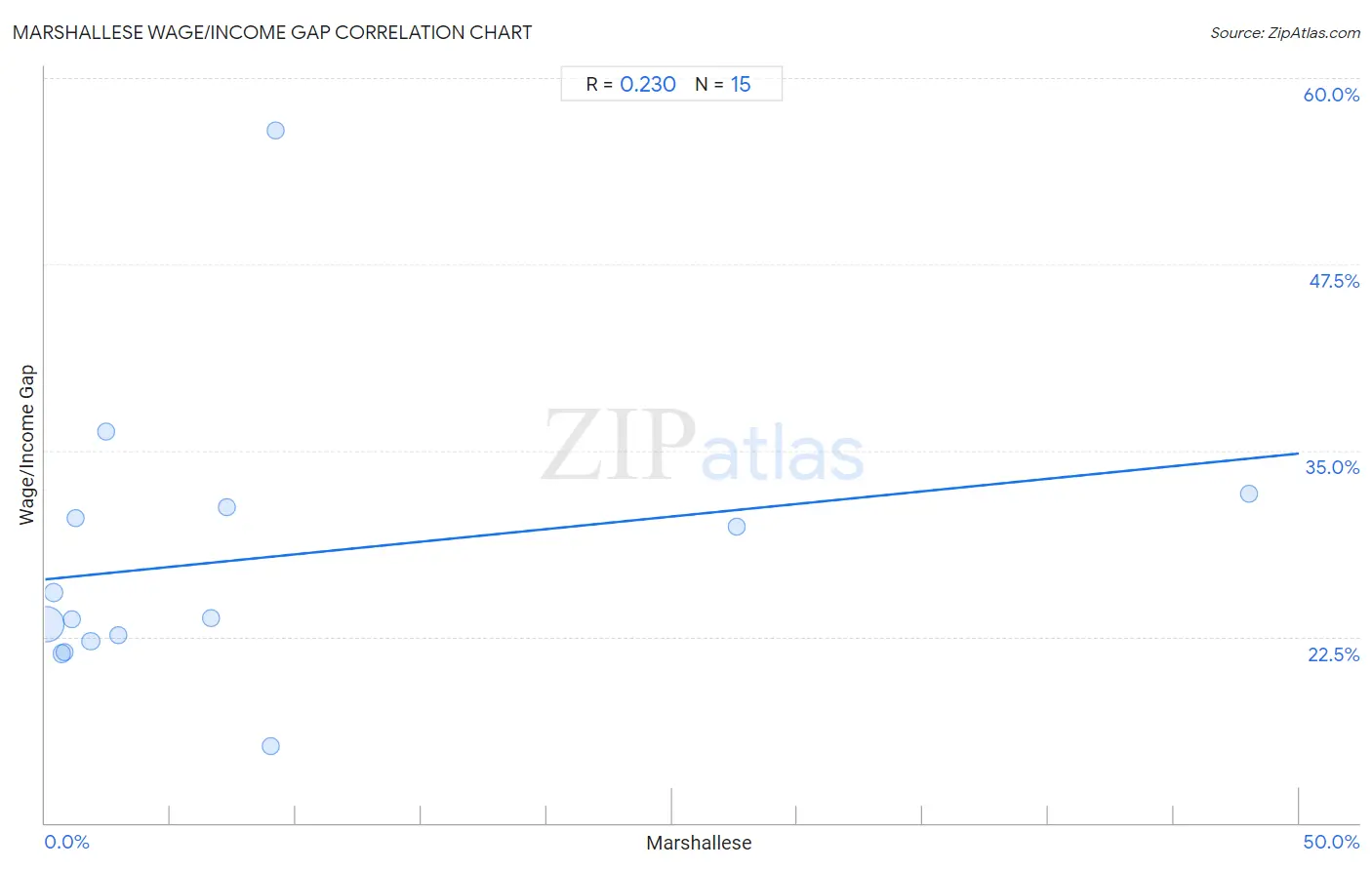Marshallese Wage/Income Gap
COMPARE
Marshallese
Select to Compare
Wage/Income Gap
Marshallese Wage/Income Gap
23.4%
WAGE/INCOME GAP
99.6/ 100
METRIC RATING
89th/ 347
METRIC RANK
Marshallese Wage/Income Gap Correlation Chart
The statistical analysis conducted on geographies consisting of 14,760,329 people shows a weak positive correlation between the proportion of Marshallese and wage/income gap percentage in the United States with a correlation coefficient (R) of 0.230 and weighted average of 23.4%. On average, for every 1% (one percent) increase in Marshallese within a typical geography, there is an increase of 0.17% in wage/income gap percentage.

It is essential to understand that the correlation between the percentage of Marshallese and wage/income gap percentage does not imply a direct cause-and-effect relationship. It remains uncertain whether the presence of Marshallese influences an upward or downward trend in the level of wage/income gap percentage within an area, or if Marshallese simply ended up residing in those areas with higher or lower levels of wage/income gap percentage due to other factors.
Demographics Similar to Marshallese by Wage/Income Gap
In terms of wage/income gap, the demographic groups most similar to Marshallese are Nicaraguan (23.4%, a difference of 0.010%), Immigrants from Panama (23.4%, a difference of 0.090%), Arapaho (23.5%, a difference of 0.15%), Immigrants from Honduras (23.5%, a difference of 0.30%), and Yuman (23.3%, a difference of 0.41%).
| Demographics | Rating | Rank | Wage/Income Gap |
| Central Americans | 99.8 /100 | #82 | Exceptional 23.1% |
| Immigrants from Africa | 99.8 /100 | #83 | Exceptional 23.2% |
| Cubans | 99.7 /100 | #84 | Exceptional 23.3% |
| Immigrants from Cambodia | 99.7 /100 | #85 | Exceptional 23.3% |
| Cheyenne | 99.7 /100 | #86 | Exceptional 23.3% |
| Yuman | 99.7 /100 | #87 | Exceptional 23.3% |
| Immigrants from Panama | 99.6 /100 | #88 | Exceptional 23.4% |
| Marshallese | 99.6 /100 | #89 | Exceptional 23.4% |
| Nicaraguans | 99.6 /100 | #90 | Exceptional 23.4% |
| Arapaho | 99.6 /100 | #91 | Exceptional 23.5% |
| Immigrants from Honduras | 99.5 /100 | #92 | Exceptional 23.5% |
| Immigrants from Cabo Verde | 99.5 /100 | #93 | Exceptional 23.6% |
| Hondurans | 99.5 /100 | #94 | Exceptional 23.6% |
| Cape Verdeans | 99.4 /100 | #95 | Exceptional 23.6% |
| Kiowa | 99.4 /100 | #96 | Exceptional 23.6% |
Marshallese Wage/Income Gap Correlation Summary
| Measurement | Marshallese Data | Wage/Income Gap Data |
| Minimum | 0.037% | 15.1% |
| Maximum | 48.0% | 56.5% |
| Range | 48.0% | 41.4% |
| Mean | 7.9% | 27.7% |
| Median | 2.5% | 23.7% |
| Interquartile 25% (IQ1) | 0.79% | 22.2% |
| Interquartile 75% (IQ3) | 9.0% | 31.2% |
| Interquartile Range (IQR) | 8.2% | 8.9% |
| Standard Deviation (Sample) | 13.1% | 9.6% |
| Standard Deviation (Population) | 12.7% | 9.3% |
Correlation Details
| Marshallese Percentile | Sample Size | Wage/Income Gap |
[ 0.0% - 0.5% ] 0.037% | 12,928,307 | 23.3% |
[ 0.0% - 0.5% ] 0.34% | 859,705 | 25.5% |
[ 0.5% - 1.0% ] 0.66% | 590,867 | 21.3% |
[ 0.5% - 1.0% ] 0.79% | 133,430 | 21.5% |
[ 1.0% - 1.5% ] 1.08% | 112,589 | 23.7% |
[ 1.0% - 1.5% ] 1.23% | 2,853 | 30.4% |
[ 1.5% - 2.0% ] 1.82% | 104,259 | 22.2% |
[ 2.0% - 2.5% ] 2.45% | 13,749 | 36.2% |
[ 2.5% - 3.0% ] 2.89% | 2,971 | 22.6% |
[ 6.5% - 7.0% ] 6.61% | 4,827 | 23.7% |
[ 7.0% - 7.5% ] 7.25% | 1,932 | 31.2% |
[ 8.5% - 9.0% ] 8.98% | 3,553 | 15.1% |
[ 9.0% - 9.5% ] 9.18% | 196 | 56.5% |
[ 27.5% - 28.0% ] 27.56% | 693 | 29.9% |
[ 47.5% - 48.0% ] 47.99% | 398 | 32.1% |